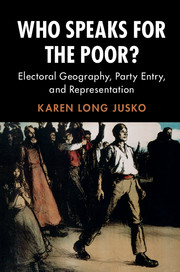Book contents
- Frontmatter
- Dedication
- Epigraph
- Contents
- List of Figures
- List of Tables
- Preface and Acknowledgments
- 1 Who Speaks for the Poor?
- 2 How Electoral Geography Matters
- 3 New Parties and the Changing Electoral Geography of Contemporary Democracies, 1880–2000
- 4 The Populists and “Third-Party Men” in America
- 5 Strategic Entry of the CCF and Social Credit in Canada
- 6 The Implications of Electoral Geography for British Labour
- 7 The Swedish Social Democratic Party, and the Long-Term Implications of Electoral Reform
- 8 “It Didn't Happen Here”: The General Implications of Electoral Geography for the Political Representation of the Poor
- References
- Index
- Miscellaneous Endmatter
7 - The Swedish Social Democratic Party, and the Long-Term Implications of Electoral Reform
Published online by Cambridge University Press: 05 September 2017
- Frontmatter
- Dedication
- Epigraph
- Contents
- List of Figures
- List of Tables
- Preface and Acknowledgments
- 1 Who Speaks for the Poor?
- 2 How Electoral Geography Matters
- 3 New Parties and the Changing Electoral Geography of Contemporary Democracies, 1880–2000
- 4 The Populists and “Third-Party Men” in America
- 5 Strategic Entry of the CCF and Social Credit in Canada
- 6 The Implications of Electoral Geography for British Labour
- 7 The Swedish Social Democratic Party, and the Long-Term Implications of Electoral Reform
- 8 “It Didn't Happen Here”: The General Implications of Electoral Geography for the Political Representation of the Poor
- References
- Index
- Miscellaneous Endmatter
Summary
The strategic entry of Sweden's Social Democrats offers a unique analytic perspective on how changing electoral geography creates new opportunities for political parties. While migration accounts for some of the changes in electoral geography that we observe in Sweden at the end of the nineteenth century, most of the changes in local distributions of electoral power resulted from the incorporation of newly eligible voters. As we shall see, although many of these new voters were long-term residents of their district, they were not part of local partisan or electoral networks until rapid economic growth increased their incomes above 800 kronor, the income level required for voter eligibility. The dramatic increase in newly available voters in some districts, especially in urban areas, created an important opportunity for the Swedish Social Democratic Party that is similar to the opportunities created by migration in the US, Canada, and the UK. Although the Social Democrats were formed in 1889, it was only after the dramatic changes in electoral geography that preceded the 1902 and especially the 1905 elections that the Social Democratic Party began to recruit candidates to compete in elections on its own label.
This chapter, like those that precede it, provides an overview of the political economy of Sweden during the late nineteenth and early twentieth centuries. Then, using historical census data and reports on typical wages during this period, this chapter maps the electoral geography of income and generates estimates of the changing size of the electorate for each electoral district. These estimates, along with official reports of the numbers of eligible voters, are used to identify electoral opportunities for the Social Democrats – and, indeed, the evidence suggests that Social Democrats were especially likely to enter electoral contests in those districts in which the number of newly available voters was comparatively large. Finally, this chapter will use the income profiles generated for each district to consider how the electoral reforms that followed shortly after the Social Democrats’ entry protected the quality of representation for low-income citizens in the long term. This last section sets the stage for the next chapter, which considers the implications of historical and contemporary electoral geography, in the US and abroad, for the political representation of low-income voters.
- Type
- Chapter
- Information
- Who Speaks for the Poor?Electoral Geography, Party Entry, and Representation, pp. 127 - 153Publisher: Cambridge University PressPrint publication year: 2017



